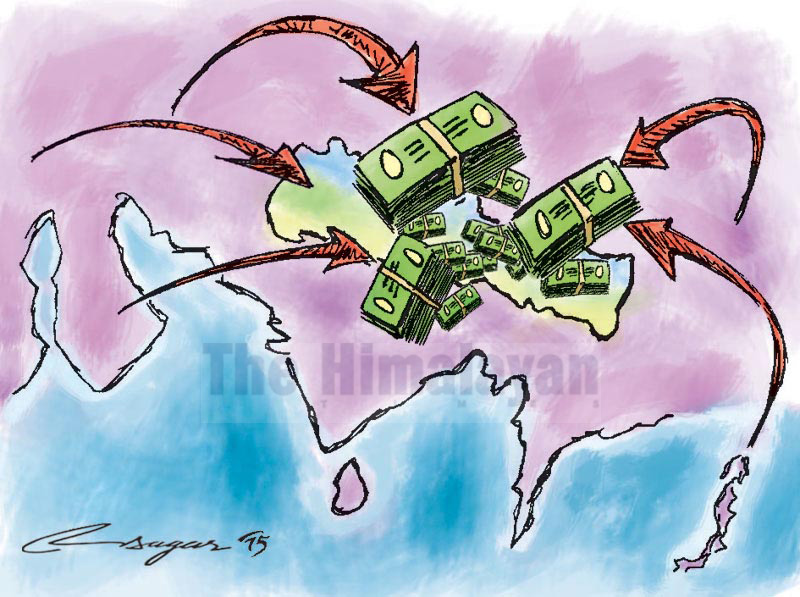Impact of COVID-19 on remittances
According to the World Bank’s latest Migration Brief, global remittances are expected to take a dramatic fall by about 20 per cent to US$ 445 billion in 2020 from US$ 554 billion in 2019 due to the economic crisis brought about by the COVID-19 pandemic along with the lockdowns. This decline, the sharpest drop in recent history, is largely attributed to a decrease in the wages and employment of migrant workers. Remittances to low and middle-income countries (LMICs), on the other hand, are also estimated to go down by 19.7 per cent to $445 billion, signifying a loss of a key financing lifeline for many vulnerable households. Despite this decline, remittance flows are expected to become even more crucial as a source of external financing for LMICs as the decline in foreign direct investment (FDI) is expected to be bigger, that is, more than 35 per cent owing to the travel bans and disruption in international trade, among others.
Compared to its increase by 6.1 per cent in 2019, remittances to South Asia are projected to plunge by 22 per cent to $109 billion in 2020. This is primarily due to the global economic slowdown arising from the pandemic along with steep fall in oil prices. While remittance inflows to the region will be adversely impacted by the economic slowdown in advanced economies, falling oil prices will impact remittance outflows from GCC, or Gulf, countries.
Though remittances alleviate poverty, improve nutritional outcomes, and are linked with higher spending on education, a decline in remittances impacts families’ ability to spend on these areas as more of their money will be aimed at solving food shortages and immediate livelihoods needs.
Until now, remittances had been an indispensable lifeline for Nepali families, especially in the rural areas. They had generally played a pivotal role in uplifting families out of poverty, allowing for investments in education, health and land. They were a critical source on which other sectors were reliant upon. They had a positive impact on government revenue and also increased liquidity in the banking system. However, it is doubtful whether this crisis will allow the Nepalis this opportunity as the situation is different now as the pandemic has adversely impacted all nations, leading to more uncertainties.
In the past, remittances had been counter-cyclical, where workers dispatched more money back home in periods of crisis. For instance, the compensatory response of remittances was a valuable mechanism for disaster relief in the aftermath of the devastating earthquake in April 2015. However, this is not true in the present context. In the ninth month of FY 2019/20, Nepal’s remittance income dropped sharply by 51.4 per cent to Rs. 34.5 billion as compared to Rs. 71 billion in the same month of FY 2018/19. Because of this, the country’s inflow of remittances fell by 4 per cent to Rs. 626.9 billion in the first nine months of FY 2019/20 in comparison to Rs. 653.2 billion in the corresponding period of the previous year. Moreover, according to the World Bank, remittances to Nepal are expected to fall by 14 per cent in 2020.
It should be recalled that remittances contributed 27.3 per cent to the country’s GDP in 2019. Currently, most of the destination countries attractive for the Nepali workers have announced a lockdown. In this situation, the effect of COVID-19 on remittances could be very damaging, and Nepal will have to forego the crucial contribution to its GDP that the country gains from remittances.
A number of Nepali migrants have already lost their jobs due to the crisis. As uncertainties of the pandemic unfolded in February and early March, a large number of workers had returned to their hometowns and villages in Nepal. Still, many migrants were unable to return after the declaration of a nationwide lockdown by the government on March 24. All in all, the coming back of overseas workers is a misfortune for Nepal as the country will lose the desperately needed hard currency. Moreover, there will be many more to the already unemployed figure. This could lead to many households gradually falling below the poverty line.
Though a few view that remittances could recover relatively quickly, as was the case in the aftermath of the global financial crisis of 2008, it will be different this time around. In the first place, COVID-19 is truly global. Secondly, with oil prices at extraordinarily low levels, employment opportunities in the oil-rich Gulf nations could come to a standstill. Thirdly, India, a popular choice for Nepal’s poor migrants, is also encountering a prolonged slowdown.
To conclude, the decline in the flow of remittances denotes the loss of a very important financing lifeline for the poor households. Still, the adverse repercussions on Nepal’s economy emanating from this decline are difficult to assess clearly, given the fact that there is uncertainty as to how long this crisis will continue.
Pant writes on globalisation and trade issues






